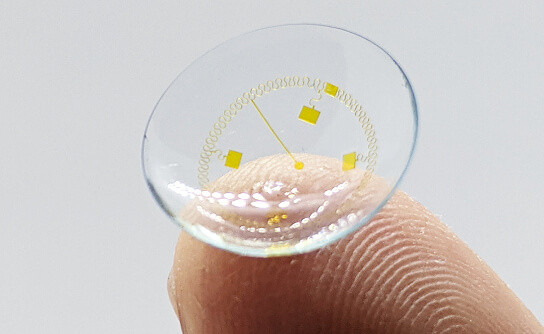InWith contact lens could power augmented reality
| 12-01-2022 | By Robin Mitchell
A recent demonstration of wearable contact technology by InWith demonstrates how contact lenses could help power augmented technologies. What challenges would a smart contact lens face, what did InWith develop, and could this be the device that marks the era of head-up displays?
What challenges would a smart contact lens face?
Creating practical wearable technology has been one of the most significant challenges researchers face. For something to be wearable, it must be comfortable, and it almost always needs to be flexible for something to be comfortable. Trying to wear anything that is ridged restricts movement, which can cause frustration very quickly.
Modern electronics are inherently solid due to the materials used to make them. For example, semiconductors generally use crystalline materials such as silicon and germanium, and these are incredibly rigid.
Components using crystalline materials are also typically reliant on the structure of the crystal and thus cannot tolerate stretching or bending.
For this reason, many electronic components can be challenging to integrate into comfortable designs that can flex and bend with the human body. Resistors and capacitors are generally not an issue, but making flexible microcontrollers and advanced digital signal processors is a very different story.
Trying to create flexible wearable electronics is clearly a challenge, but moving towards flexible contacts that sit on the surface of the eye becomes an additional order of magnitude more complex. Firstly, the eye is extremely sensitive (in fact, one of the most sensitive organs in the body), and as such, it is very easy to irritate. Contact lenses avoid this using select material that is porous and can breathe, but components such as resistors and capacitors would undoubtedly cause severe irritation.
The second challenge with creating smart contacts is that the electronics not only need to be able to fit on such a small surface, but they must do so reliably while resisting moisture and constant blinking. This gives engineers a very limited space to route circuits while simultaneously requiring engineers to walk on eggshells.
Overall, creating electronics that fit the eye is arguably the most complex challenge.
InWith demonstrating smart contact lens at CES 2022
Recently, smart contacts lens developer InWith showed off their developments in smart contact lenses at CES 2022. The company, founded by David T Markus and Michael Hayes, has created smart contact lenses that it says will help drive augmented reality technologies of the future by blending the virtual and real world together.
According to the official website for InWith, their developments in flexible contact lenses has been focused on integrating solid electronic components and circuits into hydrogel materials. This essentially allows for solid electronics to act as flexible parts when used in flexible substrates, and this technology has been demonstrated in fully functional smart lenses.
Furthermore, the InWith site describes how their technology can be used to create displays that enable users to see information in front of them without the need for a large pair of glasses (such as Google Glass). InWith also describes how smart contact lenses can be useful in the medical field for those with Myopia and Presbyopia.
However, not much information is actually given on what the new smart contact lenses are capable of, nor is there any information on their official site on the materials used. Thus, what could have been demonstrated at CES 2022 was a few different sensor circuits that have been successfully placed into a contact lens as opposed to any display technologies.

Could this be the device that starts the augmented revolution?
What has been demonstrated by InWith is a contact lens that is comfortable to wear with some embedded circuits. However, the technology does not support display technologies that allow a user to see an augmented reality, so currently, the lens is more a proof of concept for material science than an actual functioning wearable device.
But every step, even small ones, are crucial to the development of technology. A comfortable wearable device demonstrates that electronics can be integrated into the eye. The next step for such lenses would be to find methods for wirelessly transmitting power and then using that power to drive small lights. Once this has been done, display technologies can be integrated into the lens, which would mark the start of truly wearable smart contacts.

